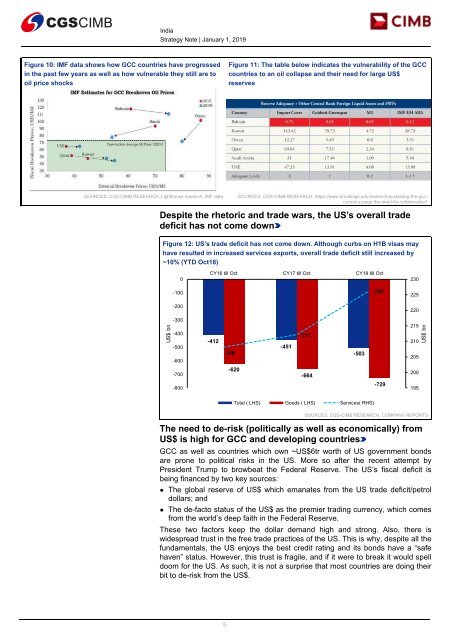Create successful ePaper yourself
Turn your PDF publications into a flip-book with our unique Google optimized e-Paper software.
Christopher Wood christopher.wood@clsa.com +852 2600 8516<br />
Figure 4<br />
Eurozone investment-grade vs high-yield corporate bond spreads<br />
180<br />
(bp)<br />
Eurozone investment-grade corporate bond spread<br />
(bp)<br />
750<br />
160<br />
Eurozone high-yield corporate bond spread (RHS)<br />
650<br />
140<br />
550<br />
120<br />
450<br />
100<br />
350<br />
80<br />
250<br />
60<br />
Jan 16<br />
Feb 16<br />
Mar 16<br />
Apr 16<br />
May 16<br />
Jun 16<br />
Jul 16<br />
Aug 16<br />
Sep 16<br />
Oct 16<br />
Nov 16<br />
Dec 16<br />
Jan 17<br />
Feb 17<br />
Mar 17<br />
Apr 17<br />
May 17<br />
Jun 17<br />
Jul 17<br />
Aug 17<br />
Sep 17<br />
Oct 17<br />
Nov 17<br />
Dec 17<br />
Jan 18<br />
Feb 18<br />
Mar 18<br />
Apr 18<br />
May 18<br />
Jun 18<br />
Jul 18<br />
Aug 18<br />
Sep 18<br />
Oct 18<br />
Nov 18<br />
Dec 18<br />
Jan 19<br />
150<br />
Note: Investment-grade bonds based on the Bloomberg Barclays Euro Aggregate Corporate Bond Index. High-yield bonds based on the BofA<br />
Merrill Lynch Euro High Yield Index. Source: Bloomberg, Federal Reserve Bank of St. Louis<br />
Such market action, in terms of rising credit stress, suggests to GREED & fear that an end is nearing<br />
to the monetary tightening cycle in the US. Yet the so-called “dot plots” incorporating Fed governors’<br />
interest rate forecasts still suggest 50bps of tightening in 2019 and 25bps in 2020. This looks<br />
unlikely in the extreme.<br />
GREED & fear’s view remains for only one more rate hike and even that is far from certain given that<br />
rising credit spreads, if not correcting FANG stocks, are increasingly likely to get the attention of the<br />
Fed, regardless of Powell’s comments at his December press conference about the balance sheet<br />
contraction being on “autopilot” (see GREED & fear – Autopilot aversion, 20 December 2018).<br />
Meanwhile it is no surprise that monetary tightening expectations in the money markets have<br />
reduced considerably over the past quarter in response to the increasingly negative stock market<br />
action. The implied rate of the December 2019 Fed funds futures has fallen from 2.93% in early<br />
November to 2.37% at present, implying no further tightening whatsoever (see Figure 5).<br />
Figure 5<br />
December 2019 Fed funds futures implied rate<br />
3.0<br />
(%) Dec-19 Fed funds futures implied rate<br />
2.9<br />
2.8<br />
2.7<br />
2.6<br />
2.5<br />
2.4<br />
2.3<br />
2.2<br />
2.1<br />
Jan 18<br />
Feb 18<br />
Mar 18<br />
Apr 18<br />
May 18<br />
Jun 18<br />
Jul 18<br />
Aug 18<br />
Sep 18<br />
Oct 18<br />
Nov 18<br />
Dec 18<br />
Jan 19<br />
Source: Bloomberg<br />
Thursday, 3 January 2019 Page 3
















